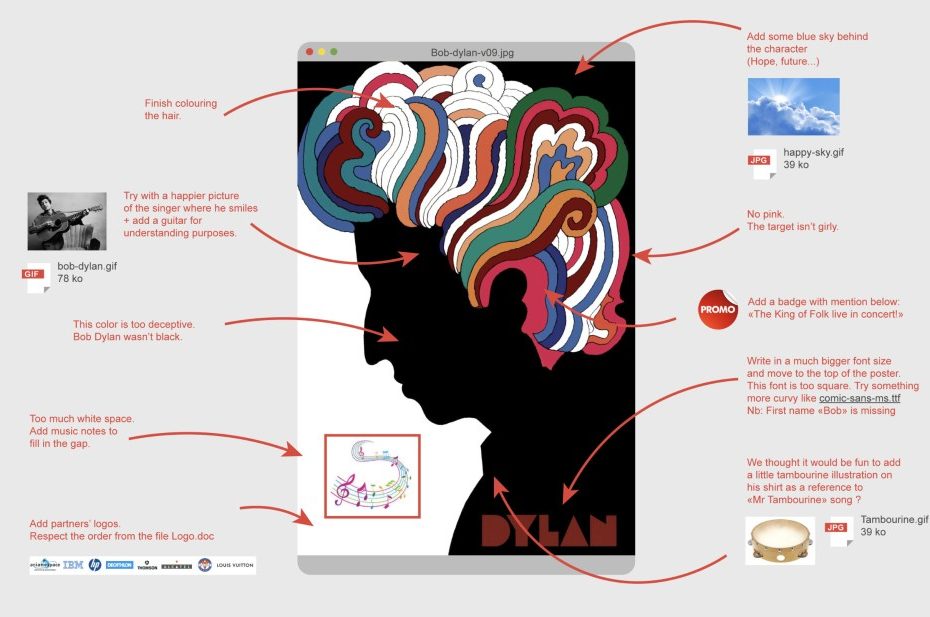Ah, feedback.

I posted designer Milton Glaser’s famous poster of Bob Dylan on LinkedIn. But there was a twist.
It was a version of the poster showing all the ways today’s colleagues and clients provide feedback. Usually on a collaborative platform like Google docs.
The photo is above. You can see how “helpful” people are.
This got me thinking about the role of feedback.
At its best, in my experience, the most valuable feedback is some form of truth.
“Hey, this idea can be stronger, have you considered..?”
Or “This post might offend someone with this or that reference.”
The feedback that I don’t like (and never liked) was when a Creative Director would say to me something like, “Keep going,” or “Have more fun with it.”
Or a client would say, ‘I don’t like it.” I’d ask why and they would say, ‘I don’t know.”
Vague is a plague.
Of course, the feedback that is the least helpful and most pernicious is “feedback in volume.”
Like this Dylan thing. If you have that much “feedback” maybe we should just delete the thing and start with a fresh screen (or piece of paper).
After years of pitching stuff to creative directors, colleagues and clients I developed a feedback framework. Let’s call it, “The Feedback Framework.”
It’s a framework that works for the person receiving the feedback. And, especially, the person giving it.
It goes like this.
You look at the work. Take a beat. And answer these three questions. (In this order, please.)
1 What’s working?
2 What’s not?
3 What’s on your wishlist?
You can use these questions for work feedback or people feedback.
(By the way, if you’re interested in the science of positive feedback, look no further than Jen Ostrich’s book, Feedback Reimagined.)
Now, back to the framework. Starting with “What’s working?” forces the feedback-er to resist the urge to crap on everything. Nine times out of 10, there is a spark of goodness in what you see. Look for that. And acknowledge it.
Question 2: “What’s not working?” This is always the loaded question. What I like to do is ask the reviewer, if they are giving me a lot of feedback, to stop for a second and offer up this: “Ok, tell me the three most pressing items for you.”
There may be more, but are some issues really that critical?
I’ve also found that people who have long lists of criticisms and love their super-detailed “gotchas” are actually not making the work better. They tend to be doing some kind of weird personal therapeutic exercise. Or at worst, just showing off.
Gimme three things that aren’t working. Three big things. Better yet, tell me the one or two things that will really make a difference.
Question three: “What’s on your wishlist?” You saw the work, (or I’ve been not performing to your standard, fine). What’s your ideal? What’s your dream? What would you do if you could do anything? And if it’s personal feedback, what’s the ideal way I should be performing?
The Feedback Framework. A clear way to get to feedback that moves us all forward.
By the way, feel free to give me feedback on this post:
What’s working?
What’s not?
What’s on your wishlist?
Rob Schwartz is the Chair of the TBWA New York Group and an executive coach who channels his creativity, experience and wisdom into helping others get where they want to be. This was originally posted on his Substack, RobSchwartzHelps, where he covers work, life, and creativity.
Image composite courtesy the author.
